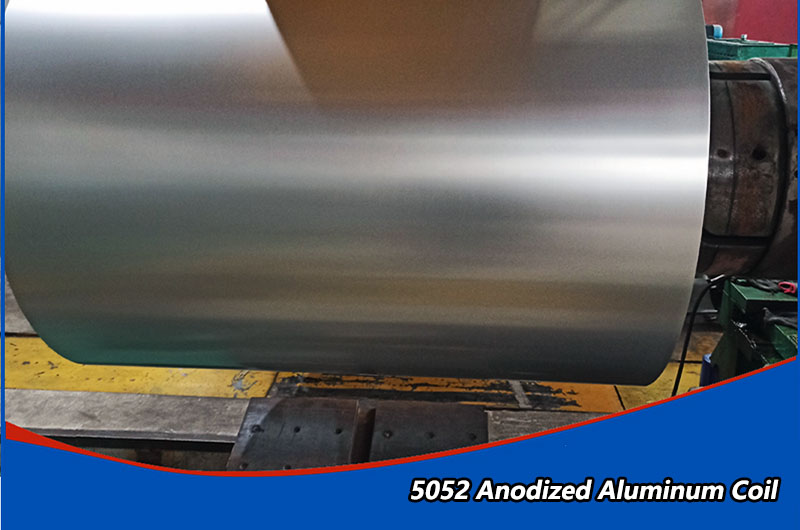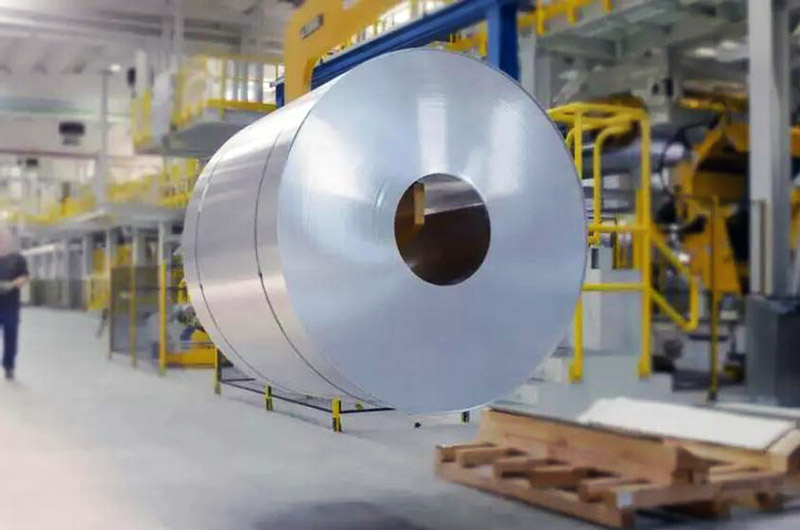5052 aluminum oxide coil refers to a rolled product made of 5052 aluminum alloy, and the surface has been oxidized.
Oxidation treatment of 5052 aluminum coil can improve its surface hardness, wear resistance and corrosion resistance. The aluminum oxide layer also provides a degree of insulating properties. Oxidation treatment typically involves exposing aluminum materials to an oxidizing environment, such as using acidic or alkaline solutions, to form a thin film of aluminum oxide.

Although aluminum and aluminum alloys can naturally form an oxide film in the atmosphere, the film is thin (40-50A), loose and porous, amorphous, uneven and continuous, and cannot be used as a reliable protection or decoration. sexual membrane layer.
- 1. The thickness of the oxide film obtained by chemical oxidation treatment is generally 0.3 to 4um, and its softness, wear resistance and corrosion resistance are lower than those of the anodized film. Therefore, it is rarely used alone except for special purposes. However, it has good adsorption capacity, and painting on its surface can effectively improve the corrosion resistance and decorative properties of 5052 aluminum.
- 2. The thickness of the oxide film obtained by anodizing treatment is generally 5-20v m, and the thickness of the hard anodized film can reach 60-2500m.
5052 Anodized Aluminum Coil Features
(1) It has good insulation properties.
The anodized film of aluminum and aluminum alloys no longer has the conductive properties of metal and has become a good insulating material.
(2) It has strong adsorption capacity.
The anodized film of aluminum and aluminum alloys has a porous structure and has strong adsorption capacity, so filling the pores with various pigments, lubricants, resins, etc. can further improve the protection, insulation, wear resistance and decorative properties of aluminum products.
(3) Strong insulation and heat resistance.
The anodized film can withstand temperatures around 1500°C, while pure aluminum can only withstand 660°C. After chemical oxidation treatment of aluminum and aluminum alloys, especially anodization treatment, the oxide film formed on the surface has good protective and decorative properties.
(4) Higher hardness.
The hardness of pure aluminum oxide film is higher than that of aluminum alloy oxide film. Usually, its hardness is related to the alloy composition of aluminum and the technical conditions of the electrolyte during anodization. The anodized film not only has higher hardness, but also has better wear resistance. In particular, the porous oxide film on the surface layer has the ability to absorb lubricants and can further improve the wear resistance of the surface.
(5) It has high corrosion resistance.
This is due to the high chemical stability of the anodized film. After testing, the anodized film of pure aluminum has better corrosion resistance than the anodized film of aluminum alloy. This is because the alloy components contain or form metal compounds that cannot be oxidized or dissolved, causing the oxide film to be discontinuous or create gaps, thereby greatly reducing the corrosion resistance of the oxide film. Therefore, generally the film obtained after anodization must be sealed to improve its corrosion resistance.

5052 Anodized Aluminum Coil Process
5052 aluminum coil is an aluminum alloy coil with good corrosion resistance and formability. Hard oxidation is a surface treatment method that can improve its corrosion resistance and hardness. The following are some common tips when hard oxidizing 5052 aluminum coils:
- Surface treatment preparation: Before hard oxidation, ensure that the surface of the 5052 aluminum coil is clean and free of grease, dust and other impurities. Common cleaning methods include alkaline cleaning and acid cleaning.
- Pickling Treatment: Use an appropriate pickling solution, such as sulfuric or phosphoric acid, to remove surface oxides and other contaminants. This helps improve the quality and uniformity of the hard oxide.
- Anodizing process: Place the 5052 aluminum coil into a suitable electrolytic tank, which serves as the anode and guides the oxidation process through current. Control factors such as current density, electrolyte composition and temperature to obtain the desired hard oxide layer.
- Current Density Control: Precise control of current density is important to achieve a uniform and dense oxide layer. Current densities in different areas may result in inconsistent colors or uneven oxide layers.
- Electrolyte Control: Select the appropriate electrolyte composition and concentration to ensure the formation of a strong, wear-resistant oxide layer. Typical electrolytes include sulfuric acid, oxidants, and other additives.
- Temperature control: Controlling the temperature of the electrolyte helps control the rate of oxidation reaction and affects the formation and quality of the oxide layer.
- Post-processing: After completing the oxidation process, perform appropriate post-processing, such as sealing or applying sealant, to improve the sealing and corrosion resistance of the oxide layer.
- Quality Testing: Quality testing is performed, including measuring the thickness, hardness and corrosion resistance of the oxide layer, to ensure compliance with specifications.
5052 Anodized Aluminum Coil Applications
5052 alumina coil is widely used in many different fields due to its excellent performance characteristics. Here are some possible applications:
- Aerospace Industry: The high strength and lightweight properties of 5052 aluminum alloy make it a commonly used material in the aerospace industry. Oxidation treatment provides the advantages of resisting corrosion and improving surface hardness, and is suitable for components such as aircraft structures, wings, and spacecraft casings.
- Automobile manufacturing: 5052 alumina coils are also widely used in automobile manufacturing. It can be used in automobile body panels, doors, roofs and other structural parts, and its excellent corrosion resistance helps improve the life and durability of automobiles.
- Construction field: 5052 aluminum oxide coils can be used for building exterior walls, roofs, window frames, etc. Its lightweight and weather-resistant properties make it a popular building material, while the oxidation treatment provides additional surface protection.
- Electronic equipment: Due to the excellent conductive properties of 5052 aluminum alloy, aluminum oxide rolls can be used to manufacture electronic equipment casings, radiators and other electronic components.
- Shipbuilding: Ship structures need to resist corrosion from seawater, and the corrosion resistance of 5052 aluminum oxide coils makes it an ideal choice in the shipbuilding industry.
- Food processing equipment: Due to the hygiene and corrosion resistance of aluminum materials, 5052 alumina coils can be used to manufacture food processing equipment, such as food containers, cooking utensils, etc.
Overall, the application fields of 5052 alumina coils are very wide, covering many industrial and daily fields, and its superior performance makes it an ideal choice for many application scenarios.

